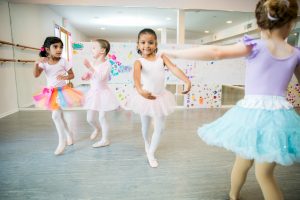How to Choose A Dance Studio
Motivations for signing children up for extracurricular activities vary from parent to parent. They may see it as a way for their child to learn teamwork, develop discipline, make new friends or simply to try something new. Rarely does a parent sign their child up for swimming so they can be in the Olympics or for soccer so they can become the next David Beckham or Mia Hamm, but that does happen, too.
Whatever the case, you want to be sure you’re selecting the best experience for your child. So when it’s time to choose a dance studio, rather than simply enrolling your child in the nearest opportunity, it’s worth some thought and a little homework. Even if your child is dancing just for fun, chances are they’ll be learning more than just dance skills. They’ll very likely be learning how to handle life.
So what to look for? Most importantly, you’ll want a studio that has a sound curriculum with solid instructors and a positive environment. How to find it? Interview studio directors to learn more about the studio philosophy. Ask to watch a class. While it may be too distracting to have a new observer in the room, some studios will offer windows or video where you can see what’s happening during the class.
As you’re asking around, interviewing and observing, here’s what to watch for:
1. A studio that teaches children how to dance rather than teaching them a dance. Children need to learn how before they can do. Your child shouldn’t spend more than half of their total annual class time learning their recital dance.
2. A facility that is clean with adequate access to water and restrooms and—very important—proper flooring. Dancing on concrete offers little protection for your dancer’s body against the wear and tear on jumping joints and bouncing bones. Additionally, if you observe an unusual number of injured dancers at a studio, it may indicate a studio’s lack of attention to technique, not just bad flooring.
3. Instructors who offer individual corrections for dancers and break down the elements of a movement so dancers fully understand the technique or combination. Instructors who have professional dancing experience as well as a degree in dance show a commitment to the arts.
4. The 4 C’s of Age-Appropriateness
Class length and size—Smaller dancers should mean shorter classes. Smaller dancers should also mean smaller class sizes than older dancers.
Communication—Instructors who speak in a friendly way and in terms your child can understand.
Choreography—Children will have their entire adult lives to act like adults. A studio that preserves and protects childhood will teach your child more valuable life skills than one that seeks to sexualize them in any way.
Costumes—Ditto. Let’s let kids be kids for as long as possible.
5. On the subject of costumes, a studio dress code can be an indicator of excellence at a studio. Dress codes ensure appropriate coverage while also allowing instructors to see the lines of the body to ensure proper technique.
6. A positive tone that encourages friendly interaction, encouragement, friendship and fun. Children need positive role models and environments that will feed their young spirits; a good dance studio will offer exactly that.
7. A variety of class types that will allow your child to explore many different dance styles: from ballet, tap and jazz to modern, contemporary and hip hop. It’s a bonus to find studios that also offer master classes with guest artists. That gives your child the opportunity to learn new choreography and learn it from someone with a different teaching and dance style.
8. A studio that pays attention to level placements and provides progress reports is a studio that is paying attention to your individual child. It’s also a studio that allows children to progress at their own pace, which in the long run saves them from unnecessary injuries.
9. Remember that note above about learning more than just great dancing? Community involvement through their dance studio will heighten dancers’ empathy and awareness of the needs of others. And that instills respect and compassion that can last a lifetime.
10. Finally, a studio that offers performance opportunities to your child. When your child participates in tennis or track, you expect that you’ll get to see the results of all the hours of practice at a match or meet. Why wouldn’t you want the same for your dancing child? After all, dance is a performance art.



